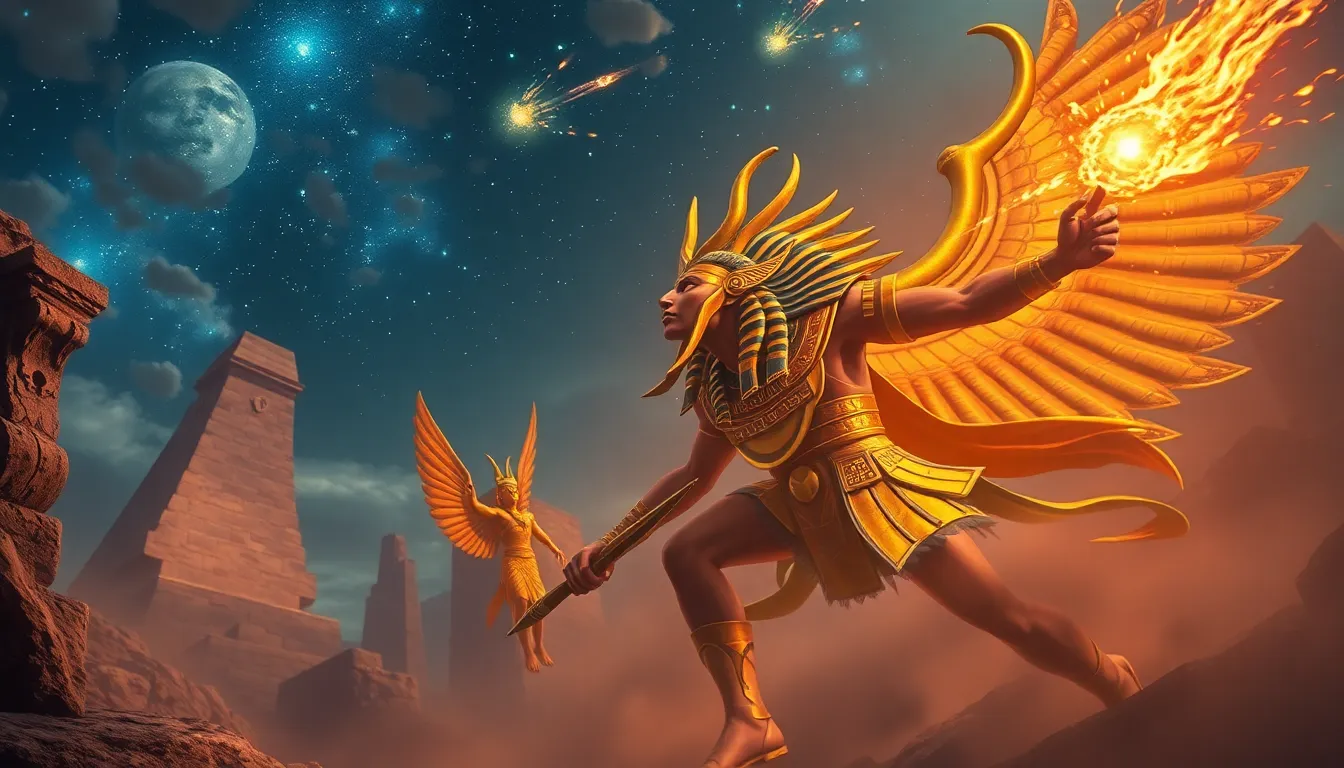The Myth of the Celestial Battle: Horus and Set
I. Introduction
Egyptian mythology is a complex tapestry of stories, gods, and symbols that reflect the ancient Egyptians’ understanding of the world and the cosmos. Among its numerous deities, two figures stand out prominently: Horus and Set. Their rivalry, rooted in themes of power, order, and chaos, forms the backbone of one of the most significant myths in Egyptian lore. This article aims to delve into the myth of Horus and Set, exploring its origins, the nature of their conflict, and the lasting implications of their celestial battle.
II. The Origins of the Myth
The myth of Horus and Set is deeply entrenched in the historical context of ancient Egypt. Horus, the falcon-headed god, is often associated with the sky, kingship, and protection. Set, on the other hand, is a complex deity, commonly linked to the desert, storms, and chaos. Their conflict can be traced back to the overarching creation myth involving Osiris, the god of the afterlife.
In this creation narrative, Osiris, the benevolent ruler, is murdered by his brother Set, who embodies disorder and jealousy. Osiris’s wife, Isis, resurrects him, leading to the birth of Horus. This sets the stage for a monumental battle between Horus, who seeks to avenge his father and reclaim the throne, and Set, who represents the chaotic forces that threaten order.
III. The Nature of the Conflict
The rivalry between Horus and Set is not merely a struggle for power; it is a profound cosmic battle embodying the eternal conflict between light and darkness. Horus represents light, order, and rightful kingship, whereas Set embodies darkness, chaos, and the disruptive forces of nature.
This conflict is deeply personal, rooted in family betrayal and revenge. The loss of Osiris not only sets Horus on a path of vengeance but also illustrates how personal grievances can escalate into larger cosmic struggles. Their battles are symbolic of the duality present in the universe, reflecting the struggle between good and evil, stability and chaos.
IV. Key Events in the Celestial Battle
The celestial battle between Horus and Set is marked by several key confrontations, each significant in its own right:
- The First Battle: This initial clash occurs soon after Horus reaches adulthood. Set uses treachery and brute force, but Horus, with the help of his mother Isis, manages to survive and regroup.
- The Contest of the Gods: In a critical showdown, both gods present their cases to the other deities, leading to a series of contests to determine who is the rightful ruler of Egypt.
- The Final Battle: After numerous trials, Horus and Set engage in a climactic battle that results in the defeat of Set. However, divine intervention plays a crucial role, as other gods, such as Thoth and Ra, support Horus in restoring order.
These battles held significant importance in the context of Egyptian cosmology, representing not just a struggle for the throne but the balance of the cosmos itself. The outcomes of these confrontations reflect the Egyptians’ understanding of order and justice in their world.
V. Interpretations and Symbolism
The myth of Horus and Set transcends mere storytelling; it serves as a powerful metaphor for the struggle between order and chaos. This duality is central to ancient Egyptian beliefs, representing the balance necessary for the continued existence of the world.
Psychologically, the conflict can be interpreted as a reflection of human nature. The themes of jealousy, betrayal, and the quest for justice resonate deeply, inviting individuals to consider their own struggles with conflict and resolution.
Culturally, this myth highlights the Egyptians’ reverence for the concept of Ma’at, or cosmic order. The resolution of the conflict between Horus and Set reinforces the necessity of maintaining balance in society and the universe.
VI. The Aftermath of the Conflict
The resolution of the battle between Horus and Set profoundly shaped Egyptian society. With Horus emerging victorious, he is established as the rightful ruler of Egypt. This triumph symbolizes the restoration of order and the divine sanctioning of kingship.
Set, despite his defeat, undergoes a transformation. He evolves from a mere god of chaos into a more misunderstood figure, often representing the necessary balance of chaos within the order. This complexity illustrates the multifaceted nature of the gods in Egyptian mythology.
VII. Modern Relevance and Legacy
The myth of Horus and Set continues to resonate in contemporary culture. Elements of their story can be seen in various forms of media, literature, and art, often serving as a backdrop for narratives involving conflict and resolution.
When comparing this myth to other mythological battles, such as the Greek Titanomachy or the Norse Ragnarok, one can observe similar themes of order versus chaos and the cyclical nature of conflict. These stories remind us of the universal struggles that societies face, echoing lessons about balance and justice.
In today’s world, the lessons drawn from the Horus and Set conflict encourage individuals to reflect on their own lives. The need for order in the face of chaos remains relevant, underscoring the importance of resilience and purpose in overcoming adversities.
VIII. Conclusion
The myth of Horus and Set encapsulates significant themes that resonate across cultures and eras. The struggle between light and darkness, order and chaos, remains a timeless narrative that invites reflection and exploration.
As we delve deeper into the pathways of Egyptian mythology, we uncover not just stories of gods and battles but profound insights into the human experience. The enduring nature of the Horus and Set myth encourages further exploration of its relevance, fostering a greater understanding of the complexities of life and the cosmos.




